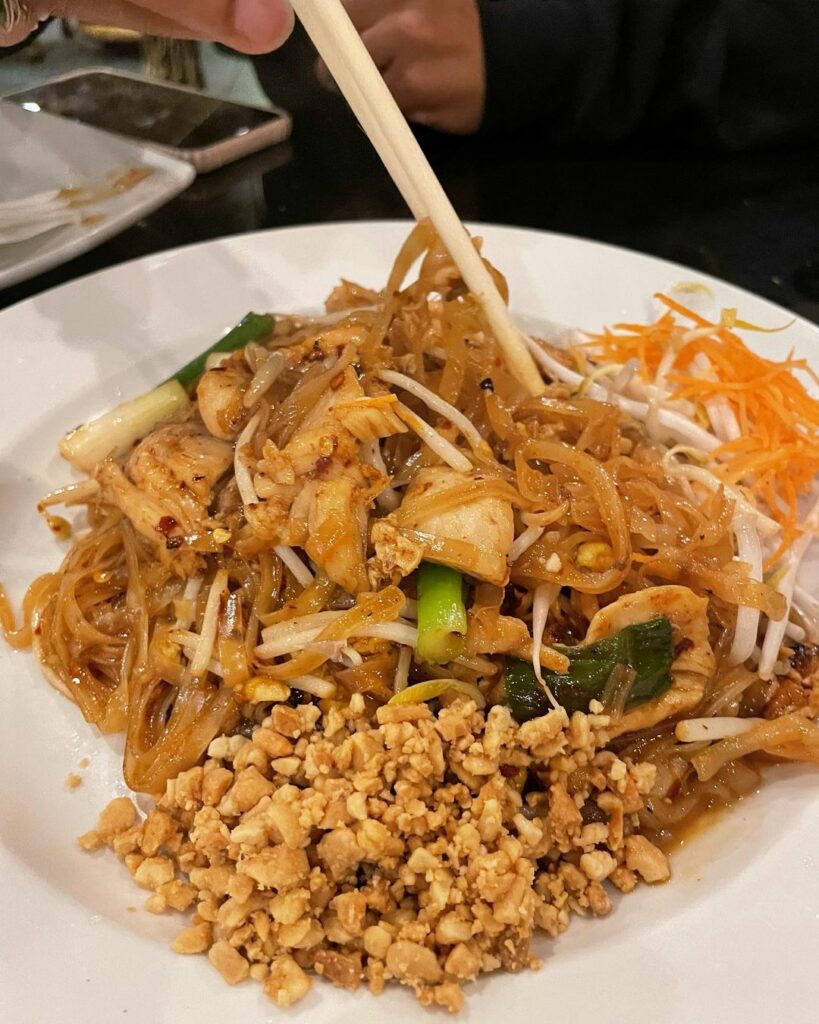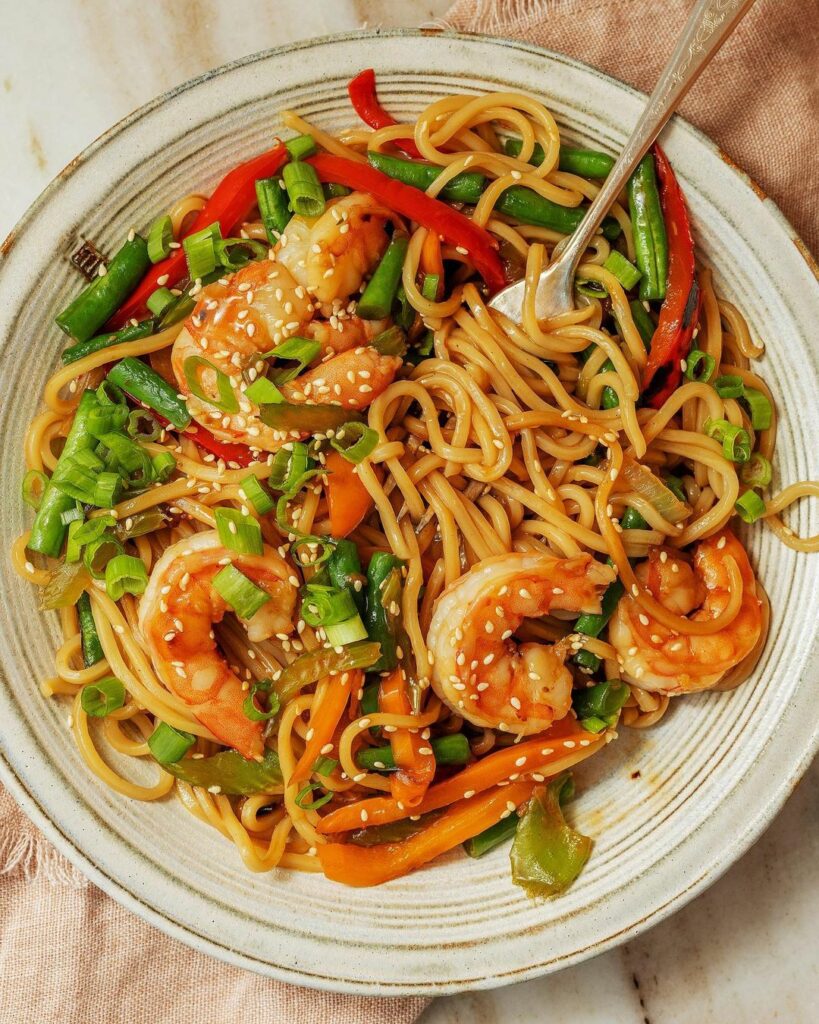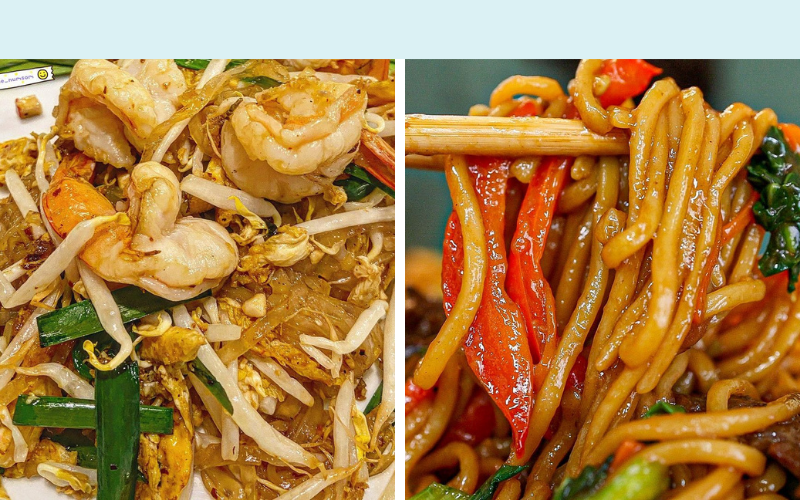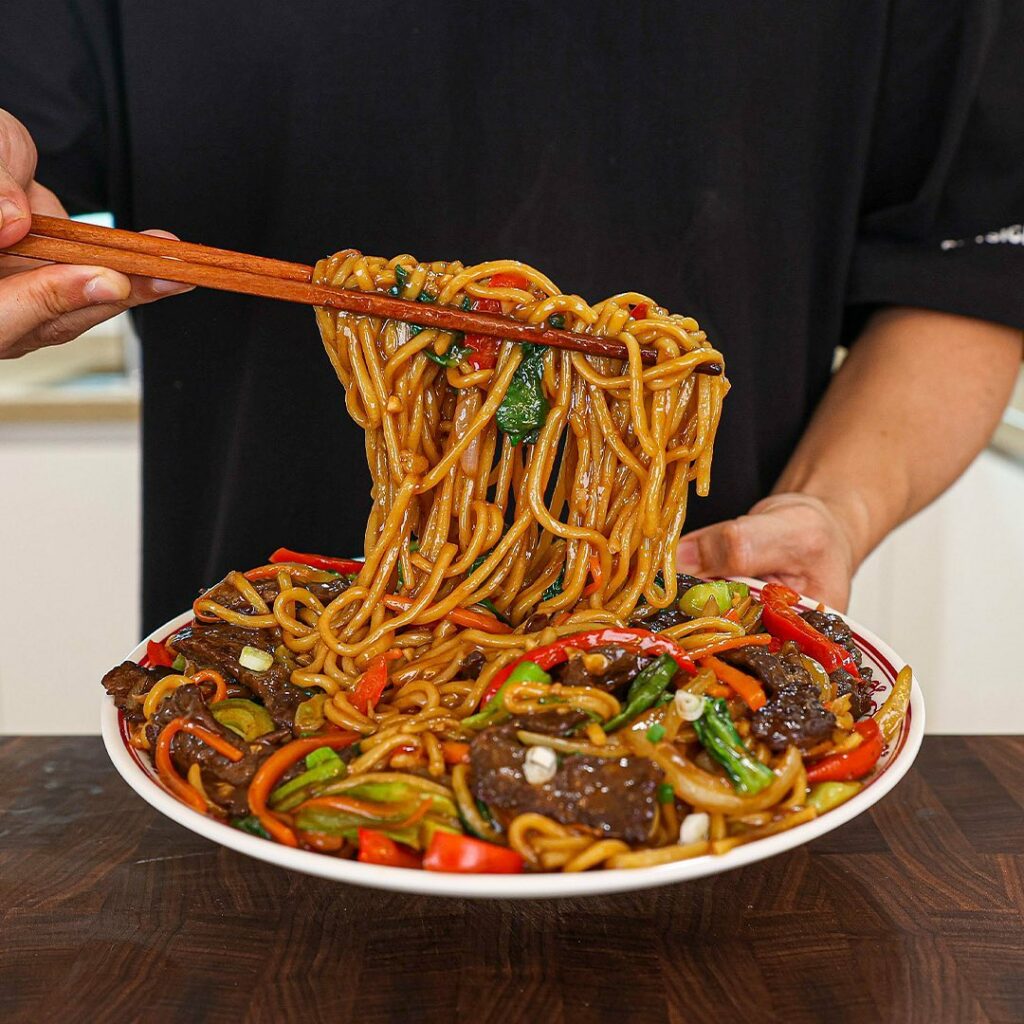Pad Thai vs Lo Mein are two popular dishes in the realm of Asian cuisine, each with its unique characteristics and flavors. Pad Thai, originating from Thailand, is a stir-fried noodle dish typically made with rice noodles, eggs, tofu, peanuts, and tamarind sauce.
On the other hand, Lo Mein, hailing from China, consists of egg noodles tossed with a variety of vegetables, meat, and savory sauces. In recent years, Asian cuisine has gained tremendous popularity worldwide, attracting food enthusiasts with its rich and diverse flavors.
Moreover, the emphasis on health and nutrition has become a significant aspect of modern food choices. In this article, we will delve into the comparison of Pad Thai and Lo Mein, examining their ingredients, nutritional aspects, and exploring which dish offers a healthier option for those seeking a balance between taste and well-being.
Maybe you concern: Pad See Ew Vs Pad Thai
What is pad Thai?

Pad Thai is a popular dish originating from Thailand. It holds significant cultural significance as one of the country’s most iconic culinary creations. Traditionally, Pad Thai consists of stir-fried rice noodles cooked with a combination of ingredients such as eggs, tofu, bean sprouts, garlic, shallots, and a protein source like shrimp, chicken, or tofu.
The flavors are enhanced with a tangy and slightly sweet tamarind-based sauce, along with a sprinkle of crushed peanuts and a squeeze of lime for added freshness. While the classic recipe remains consistent, there are various regional and personal variations of Pad Thai, incorporating different vegetables, proteins, and spices to suit individual tastes.
The dish is known for its harmonious balance of sweet, sour, and savory flavors, making it a beloved choice among Thai cuisine enthusiasts worldwide.
What is Lo Mein?

Lo Mein is a Chinese dish that has gained popularity across the globe. Its origins can be traced back to the Cantonese region of China. Lo Mein typically consists of egg noodles that are cooked until they are tender and then tossed with a variety of ingredients such as vegetables, meat, and seafood.
The dish is known for its versatility, allowing for different combinations of ingredients based on regional preferences and personal tastes.
The flavor profiles of Lo Mein can vary depending on the ingredients used, but it often encompasses a combination of savory, umami, and slightly sweet notes. Common additions include soy sauce, oyster sauce, garlic, ginger, and a hint of sesame oil to enhance the overall taste. The result is a satisfying and flavorful dish that showcases the art of Chinese culinary techniques and showcases the rich diversity of Chinese cuisine.
What are the key ingredients of pad Thai and lo mein?
Pad Thai
The key ingredients of Pad Thai typically include:
- Rice noodles: Flat and wide rice noodles form the base of Pad Thai.
- Protein: Commonly, shrimp, chicken, or tofu are used as the protein source.
- Eggs: Beaten eggs are stir-fried with the noodles and other ingredients.
- Bean sprouts: Crispy bean sprouts add texture and freshness to the dish.
- Tamarind sauce: A tangy and slightly sweet sauce made from tamarind pulp is a defining element of Pad Thai.
- Peanuts: Crushed peanuts are often sprinkled on top as a garnish.
- Garlic and shallots: These aromatic ingredients provide depth of flavor.
- Fish sauce: A savory and salty condiment that adds umami taste to the dish.
- Lime: A squeeze of lime juice is added for a touch of acidity.
- Thai chili peppers (optional): For those who enjoy spicy food, Thai chili peppers can be added for heat.
Lo Mein
The key ingredients of Lo Mein may vary based on regional variations and personal preferences, but the common elements include:
- Egg noodles: These are the main component of Lo Mein, providing a chewy texture.
- Vegetables: Commonly used vegetables include bell peppers, broccoli, carrots, mushrooms, and bok choy.
- Protein: Chicken, beef, pork, shrimp, or tofu are often added for protein.
- Soy sauce: This savory sauce lends a rich flavor and adds a dark color to the noodles.
- Oyster sauce: A thick and savory sauce made from oysters contributes depth of flavor.
- Garlic and ginger: These aromatic ingredients enhance the taste profile of the dish.
- Sesame oil: A drizzle of sesame oil provides a nutty and fragrant note.
- Scallions: Sliced scallions are used as a garnish, adding freshness and color.
Which is healthy, pad Thai or lo mein?
Is lo mein healthy? Is pad Thai healthy? These are common questions that arise when comparing these two popular Asian noodle dishes. To determine their relative healthiness, it’s important to conduct a nutritional analysis and evaluate their macronutrients, micronutrients, and cooking methods.
Let’s take a closer look at the nutrient facts of Pad Thai and Lo Mein in the following table:
| Nutrients | Pad Thai (per serving) | Lo Mein (per serving) |
| Calories | 450-550 | 400-500 |
| Total Fat (g) | 15-25 | 10-15 |
| Saturated Fat (g) | 2-5 | 2-4 |
| Cholesterol (mg) | 50-100 | 30-60 |
| Carbohydrates (g) | 60-80 | 50-70 |
| Fiber (g) | 2-4 | 3-5 |
| Protein (g) | 10-15 | 12-18 |
| Sodium (mg) | 800-1200 | 800-1000 |
| Vitamin C (mg) | 10-20 | 8-15 |
| Vitamin A (IU) | 500-1000 | 400-800 |
| Calcium (mg) | 50-100 | 40-80 |
| Iron (mg) | 2-4 | 2-5 |
Note: Nutrient values may vary depending on specific recipes and portion sizes.
Lo mein vs pad Thai healthier can be part of a balanced diet. However, the specific healthiness of each dish depends on various factors such as ingredients, cooking methods, and portion sizes.
While Pad Thai tends to have a slightly higher calorie and fat content compared to Lo Mein, it also provides higher amounts of certain vitamins and minerals. On the other hand, Lo Mein often contains more fiber and protein. It’s important to note that the nutrient values mentioned above are approximate and can vary based on individual recipes and variations.
When comparing Lo Mein to Chow Mein, Lo Mein is often considered the healthier option. It is typically stir-fried with less oil and includes a variety of vegetables, providing additional nutrients and fiber. Chow Mein, on the other hand, is often deep-fried or pan-fried, which increases its calorie and fat content.
What are the differences between pad Thai vs lo mein?

Here is a comparison table highlighting the main differences between Pad Thai and Lo Mein:
| Aspect | Pad Thai | Lo Mein |
| Cuisine origin | Thai | Chinese |
| Noodle type | Rice noodles | Egg noodles |
| Flavor profile | Sweet, tangy, savory | Savory, umami |
| Protein options | Shrimp, chicken, tofu | Chicken, beef, pork, shrimp, tofu |
| Sauce | Tamarind-based | Soy sauce-based |
| Key ingredients | Tamarind sauce, peanuts, bean sprouts | Soy sauce, vegetables, protein |
| Cooking method | Stir-fried | Stir-fried |
| Garnish | Crushed peanuts, lime | Scallions, sesame oil |
| Spiciness | Can be mild or spicy | Generally not spicy |
| Cultural significance | Iconic Thai dish | Popular Chinese dish |
| Regional variations | Various adaptations | Various adaptations |
While both Pad Thai and Lo Mein are delicious noodle dishes, they differ in terms of their cuisine origins, noodle types, flavor profiles, key ingredients, and cultural significance.
Pad Thai leans towards a sweet, tangy, and savory taste with the prominent use of tamarind sauce and peanuts, while Lo Mein has a savory and umami flavor profile, primarily derived from soy sauce and various vegetables and proteins.
Additionally, Pad Thai is associated with Thai cuisine, while Lo Mein is a popular dish in Chinese cuisine. Both dishes offer versatility and can be adapted based on regional preferences and personal tastes.
What are the similarities between pad Thai and lo mein?
Pad Thai and Lo Mein, despite their cultural origins and flavor profiles, do share some similarities:
- Noodle-based dishes: Both Pad Thai and Lo Mein are noodle-based dishes, providing a satisfying and filling meal.
- Versatility: Both dishes offer versatility in terms of ingredient choices. You can customize them by adding various vegetables, proteins, and sauces to suit your taste preferences.
- Stir-frying technique: Pad Thai and Lo Mein are typically prepared using a stir-frying technique, where the noodles and other ingredients are quickly cooked in a hot pan or wok. This cooking method helps to infuse flavors and create a delicious dish.
- Balance of flavors: While the specific flavor profiles differ, both Pad Thai and Lo Mein strive for a harmonious balance of sweet, savory, and umami flavors. They often incorporate ingredients like soy sauce, garlic, and other seasonings to achieve this balance.
- Popular Asian cuisine: Pad Thai and Lo Mein are widely recognized and enjoyed as popular dishes in Asian cuisine. They have gained popularity and are often offered in Asian restaurants worldwide.
Can you use pad Thai noodles for lo mein?
Can you use Pad Thai noodles for Lo Mein? Let’s compare the characteristics of Pad Thai and Lo Mein noodles to assess the feasibility of substituting them.
Pad Thai noodles are flat and wide rice noodles, whereas Lo Mein noodles are egg noodles that are typically thicker and have a chewier texture. The difference in noodle types contributes to the distinct characteristics and textures of each dish.
Substituting Pad Thai noodles for Lo Mein is possible, but it will have an impact on the taste and texture of the final dish. Since Pad Thai noodles are thinner and softer, they may absorb sauces more readily and have a tendency to become mushy if cooked for too long. On the other hand, the thicker and chewier texture of Lo Mein noodles provides a more substantial bite and stands up well to stir-fry.
If you decide to use Pad Thai noodles in a Lo Mein recipe, it’s essential to adjust the cooking time to prevent overcooking and maintain the desired texture.
You may also need to consider the amount of sauce or moisture in the dish, as Pad Thai noodles might absorb more liquid compared to the heartier Lo Mein noodles.
While it is possible to use Pad Thai noodles as a substitute, it’s worth noting that the resulting dish may not fully replicate the authentic taste and texture of traditional Lo Mein. However, experimenting with different noodle types can offer a unique twist and add an interesting element to your culinary exploration.
How to store pad Thai and lo mein?
To store Pad Thai and Lo Mein for later consumption, follow these guidelines:
- Allow the dish to cool down: Let Pad Thai or Lo Mein cool to room temperature before storing to prevent condensation and maintain optimal texture.
- Refrigeration: Transfer the noodles and any accompanying sauce or toppings into airtight containers or zip-top bags. Place them in the refrigerator within two hours of cooking.
- Proper labeling: Label the containers with the date to keep track of freshness.
- Storage duration: Pad Thai and Lo Mein can typically be refrigerated for up to 3-4 days. Beyond that, the quality and taste may deteriorate.
- Freezing (optional): If you want to extend the storage time, you can freeze Pad Thai or Lo Mein. Transfer the cooled noodles to freezer-safe containers or bags, and ensure they are tightly sealed. Properly frozen, they can last for up to 1 month.
Reheating:
- Microwave: Place a portion of the Pad Thai or Lo Mein in a microwave-safe dish, cover, and heat in intervals of 30 seconds, stirring in between, until thoroughly heated.
- Stovetop: Heat a skillet or wok over medium heat and add a small amount of oil. Add the refrigerated noodles and stir-fry for a few minutes until heated through.
Note: It’s essential to check the internal temperature to ensure the noodles are reheated to a safe level (165°F or 74°C) before consumption.
Cooking tips for healthier noodles

When it comes to cooking noodles in a healthier way, here are some useful tips to consider:
- Cooking techniques to reduce calorie and fat content: Opt for cooking methods like boiling or steaming instead of frying. This helps to minimize the amount of added oil and reduce overall calorie and fat intake.
- Adding vegetables and lean proteins for a nutritious boost: Enhance the nutritional value of your noodles by incorporating an array of colorful vegetables, such as broccoli, carrots, bell peppers, and spinach. These additions provide vitamins, minerals, and fiber. Additionally, consider adding lean proteins like grilled chicken, shrimp, tofu, or edamame to create a well-balanced meal.
- Utilizing sauces and seasonings with lower sodium content: Sodium levels in noodles can be reduced by using low-sodium soy sauce or tamari, as well as other flavor-enhancing ingredients like ginger, garlic, herbs, and spices. This allows you to maintain the taste without excessive sodium intake.
- Choosing whole grain or alternative noodles: Explore options like whole grain noodles or noodles made from alternative grains like brown rice, quinoa, or buckwheat. These varieties offer higher fiber content and additional nutrients compared to refined white noodles.
- Controlling portion sizes: Pay attention to portion sizes to avoid overeating. Moderation is key, as even healthier noodle options can contribute to calorie intake if consumed in large quantities. Balance noodles with ample servings of vegetables and proteins to create a satisfying and nutritious meal.
FAQs
Are pad Thai and Lo Mein suitable for vegetarians?
Yes, both Pad Thai and Lo Mein can be made suitable for vegetarians. In fact, they can be excellent options for vegetarian meals. By omitting or substituting the protein sources like shrimp, chicken, or beef with vegetarian alternatives such as tofu, tempeh, or seitan, you can create vegetarian versions of these dishes.
Additionally, both Pad Thai and Lo Mein offer ample opportunities to incorporate a variety of vegetables, providing essential nutrients and adding vibrant colors and textures to the meal. Whether you choose Pad Thai or Lo Mein, vegetarian adaptations can be made to cater to a vegetarian diet without compromising on taste and enjoyment.
Is lo mein Chinese or Japanese?
Lo Mein is a Chinese dish. It is a staple of Chinese cuisine and is widely enjoyed in various regions of China. While it is popular in Chinese-American cuisine as well, it is not typically associated with Japanese cuisine.
Why is Pad Thai so orange?
Pad Thai is often orange due to the use of tamarind sauce in its preparation. Tamarind sauce, a key ingredient in Pad Thai, contributes to its distinct tangy and slightly sweet flavor profile while also imparting a rich orange hue.
The tamarind pulp used to make the sauce has a naturally vibrant orange color, which is then incorporated into the dish during the stir-frying process. Additionally, other ingredients such as tomato paste, palm sugar, or chili powder may also contribute to the orange hue of Pad Thai, depending on the recipe and regional variations.
Is Pad Thai spicier than Lo Mein?
The level of spiciness in Pad Thai and Lo Mein can vary depending on the recipe and personal preferences. Pad Thai typically offers a balance of sweet, savory, and tangy flavors, with a mild to moderate level of spiciness.
It may contain Thai chili peppers or chili sauce, but the spiciness can be adjusted according to individual taste. On the other hand, Lo Mein is not traditionally a spicy dish, although some variations may incorporate mild heat with the addition of chili oil or chili flakes. Overall, Pad Thai tends to have a higher likelihood of being spicier compared to Lo Mein.
Can Pad Thai and Lo Mein be made gluten-free?
Is Pad Thai gluten free? And Lo Mein? Both Pad Thai and Lo Mein can be made gluten-free with appropriate ingredient substitutions. For Pad Thai, using gluten-free rice noodles and gluten-free versions of sauces such as tamari or gluten-free soy sauce can make it gluten-free.
Lo Mein can be made gluten-free by using gluten-free egg noodles or alternative gluten-free noodles and ensuring that the sauces and seasonings used are free from gluten. It’s important to check labels and verify that all ingredients used are certified gluten-free to accommodate individuals with gluten sensitivities or celiac disease.
Are Pad Thai and Lo Mein commonly found on the menus of Asian restaurants?
Yes, Pad Thai and Lo Mein are both commonly found on the menus of Asian restaurants. They are popular and well-known dishes in Asian cuisine, enjoyed by a wide range of people.
You can often find them listed under the noodle or stir-fry sections of the menu in restaurants that serve Asian cuisine, particularly those that specialize in Thai or Chinese dishes.
Can Pad Thai and Lo Mein be reheated?
Yes, Pad Thai and Lo Mein can be reheated. When reheating, it is best to use gentle heat to avoid overcooking or drying out the noodles. You can reheat them in a microwave by covering the dish with a microwave-safe lid or wrap and heating in short intervals, stirring occasionally to ensure even heating.
Alternatively, you can reheat them in a skillet or wok over medium heat, adding a little oil or sauce to prevent sticking and to add moisture. Reheating methods may vary based on personal preference and the specific dish, but with proper care, Pad Thai and Lo Mein can be successfully reheated for a delicious meal.
Are Pad Thai and Lo Mein suitable for kids?
Yes, Pad Thai and Lo Mein can be suitable for kids. However, it depends on the individual child’s preferences and dietary restrictions. Both dishes typically include noodles, vegetables, and protein, making them well-rounded options.
You can adjust the spice level to be milder for young children or those who are sensitive to heat. It’s also possible to customize the ingredients to cater to specific tastes or dietary needs. As always, it’s important to consider any allergies or dietary restrictions that the child may have before preparing these dishes.
Can you make Pad Thai and Lo Mein with zucchini noodles?
Yes, it is possible to make Pad Thai and Lo Mein with zucchini noodles, also known as zoodles. Zucchini noodles are a popular and healthier alternative to traditional wheat or rice noodles, as they are low in carbs and calories.
To make Pad Thai or Lo Mein with zucchini noodles, you would typically spiralize the zucchini into noodle-like strands and then stir-fry them with the desired vegetables, proteins, and sauces. Keep in mind that zucchini noodles have a different texture compared to traditional noodles, so the final dish may have a slightly different mouthfeel.
However, this can be a creative and nutritious option for those looking to reduce their carb intake or incorporate more vegetables into their meals.
Are Pad Thai and Lo Mein dishes suitable for people with nut allergies?
It’s important to exercise caution when considering Pad Thai and Lo Mein for individuals with nut allergies. Pad Thai traditionally includes crushed peanuts as a garnish, which poses a risk for those with nut allergies.
However, it is possible to make nut-free versions of Pad Thai and Lo Mein by omitting peanuts or using alternative toppings, such as toasted sesame seeds or crispy fried onions.
When dining out or ordering from a restaurant, it is crucial to inform the staff about any allergies to ensure the dishes are prepared safely and without cross-contamination.
Can you make Pad Thai and Lo Mein spicy without chili peppers?
Yes, it is possible to make Pad Thai and Lo Mein spicy without chili peppers. The level of spiciness in these dishes can be adjusted according to personal preferences. If you prefer to make them without chili peppers, you can omit them entirely or replace them with a milder alternative such as red pepper flakes or paprika.
Alternatively, you can use a mild chili sauce or adjust the amount of spice to your desired taste. It’s important to customize the level of spiciness based on individual preferences to ensure an enjoyable dining experience.
Conclusion
Considering all the facts, the comparison between Pad Thai vs Lo Mein reveals two distinct and delectable noodle dishes with their own unique characteristics. Pad Thai, originating from Thailand, boasts a harmonious blend of sweet, tangy, and savory flavors, often accompanied by the vibrant orange hue of tamarind sauce. On the other hand, Lo Mein, a beloved Chinese dish, showcases a savory umami taste with the chewy texture of egg noodles.
While both dishes have their own cultural significance and loyal fan bases, determining a clear winner in terms of healthiness can be subjective. However, by incorporating lean proteins, an abundance of vegetables, and mindful cooking techniques, both Pad Thai and Lo Mein can be part of a balanced and nutritious meal.
Whether your preference leans toward the vibrant and tangy notes of Pad Thai or the savory and satisfying qualities of Lo Mein, both dishes offer a delightful culinary experience. With their versatility and ability to be customized to personal tastes and dietary needs, Pad Thai and Lo Mein continue to captivate food enthusiasts, embracing the rich diversity of Asian cuisine.
So, embark on a flavorful journey, explore their nuances, and savor the joys that Pad Thai and Lo Mein bring to the world of noodle delights.
Read more: Pad See Ew Vs Drunken Noodles